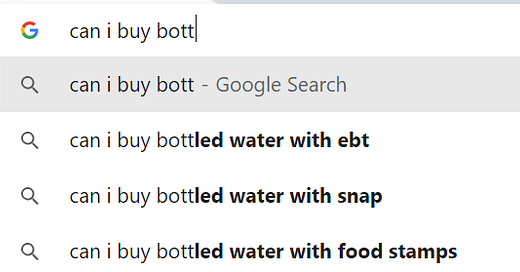Can I buy bottled water with food stamps?
As the Safe Drinking Water Act and Clean Water Act celebrate their 50th anniversaries, they are failing rural Americans.
I started typing and Google was ready with suggestions.
Why is this such a common question in America in 2023?
The Safe Drinking Water Act excludes private wells
On the Safe Drinking Water Act website The EPA states that "Over 92 percent of the population supplied by community water systems receives drinking water that meets all health-based standards all of the time." SDWA does not regulate private wells which serve fewer than twenty five individuals. These wells serve thirteen percent of Americans.
In my home state of Washington, that percentage is higher. Around one and a half million primarily rural residents rely on individual wells, while thousands more rely on unregulated small group wells. Between a fifth and a quarter of state residents are drinking unregulated water; in rural areas, that figure may be closer to half.
While lack of regulation may sound like a blessing to those allergic to government, it comes with some real downsides. These individuals and communities are ineligible for the EPA sourced grants and loans that are available to public water systems, including much of the money in the recent Bipartisan Infrastructure Law.
Many of these rural areas have other environmental concerns. The Washington Tracking Network shows the environmental and other health disparities, the social vulnerability indices, and other criteria that more than clearly define these communities as disadvantaged. And the network doesn't yet take into account the disproportionate impacts of climate change and environmental mismanagement, such as sea level rise, landslides, wildfires, and excessive heat, on these communities. Rural Washingtonians must also deal with the impacts of industrial agriculture, from declining aquifers to nitrate and pesticide contamination, on their ground and drinking water.
Those of us trying to help these communities must resort to looking under the couch cushions at state agencies for a little loose change.
The latest assault on rural drinking water comes from PFAS, per and polyfluoroalkyl substances, often called "Forever Chemicals." In the wake of the discovery of these contaminants around military facilities where firefighting foam had been used, Washington State Department of Health offered voluntary testing for these substances to all regulated water systems. Contamination above the state action limits has been found in several percent of the systems tested so far. As compulsory testing of regulated water systems rolls out across the state, many more such contamination sites will be uncovered. In many cases, it's suspected to be coming from firefighting foam used by the local fire department, where their friends and neighbors work to save lives and go home to drink the same water. And for every resident drinking water from an contaminated regulated water system, there's another served by a contaminated private well or unregulated water system who struggle to find money even for testing their water.
Those of us trying to help these communities must resort to looking under the couch cushions at state agencies for a little loose change.
The Clean Water Act excludes groundwater
If much of the drinking water is unregulated, how about the groundwater on which it relies? Unfortunately, just as private wells are excluded from the safe drinking water act, groundwater is excluded from the Clean Water Act. Born out of outrage at the Cuyahoga River fire in Ohio, its focus has always been on surface water.
One of the major sources of nitrate and other contaminants in ground water in rural Washington is cow manure from dairies and CAFOs - concentrated animal feeding operations. Although these may be required to have a NPDES (National Pollution Elimination Discharge Elimination System) permit, these focus on discharge to surface water. Furthermore, in Washington State, Ecology has handed off enforcement to the state Department of Agriculture, which has a different set of priorities.
Surf or Turf?
Animal agriculture is a major contributor to the degradation of Washington State’s Puget Sound ecosystem. While the proposed solutions address dealing with its consequences, there has been no attempt to tackle the problem at source by reducing the number of cows.
Discharge of other contaminants such as pesticides and firefighting foam to the ground and from there into groundwater is not regulated at all.
Superfund only works if there's a polluter to pay
The Superfund Act (officially know as the Comprehensive Environmental Response, Compensation and Liability Act (CERCLA) was established in 1980, again in response to public outcry about toxic waste dumps such as Love Canal and Valley of the Drums.
Born, as they were, in outrage, both Superfund and Washington State's local version, the Model Toxics Control Act, embody the principle that the polluter pays. That works well in cases like Love Canal, or the recent East Palestine train derailment and fire, but breaks down when applied to PFAS from the local fire department. No one wants to put the local fire department on the hook, and besides, they don't have any money!
Well owners near military facilities fare only slightly better, with residents in excess of the old EPA limits of 70 parts per trillion of the most hazardous PFAS compounds in their drinking water being offered bottled water, but still no permanent solutions. Meanwhile the Pentagon refuses to recognize either the lower state or even lower proposed EPA limits on these contaminants and is refusing to request the money that the administration has made available.
There's a private well-shaped hole between these well-intentioned laws.
So, what now?
There's a private well-shaped hole between these well-intentioned laws. In future posts, we'll look at some potential alternative approaches to securing safe drinking water for rural communities.
The answer, by the way, is yes, you can use your SNAP benefits to buy bottled water. At the supermarket checkout at least, no one asks if you’re a private well owner.






